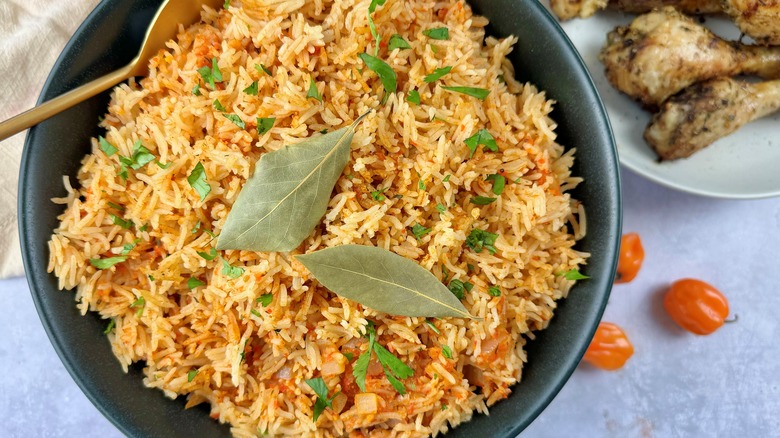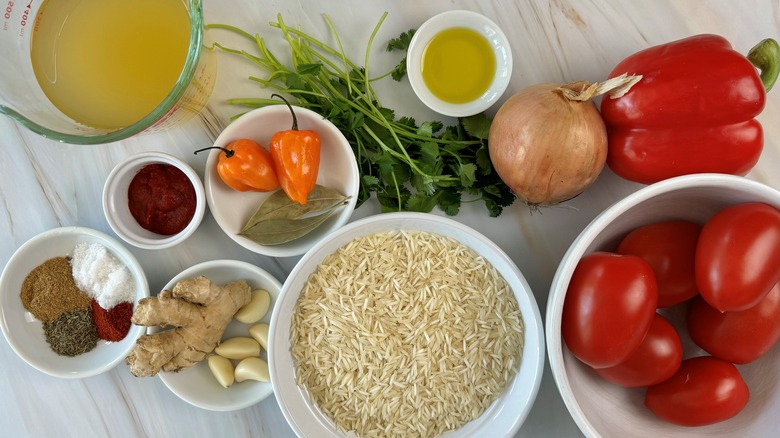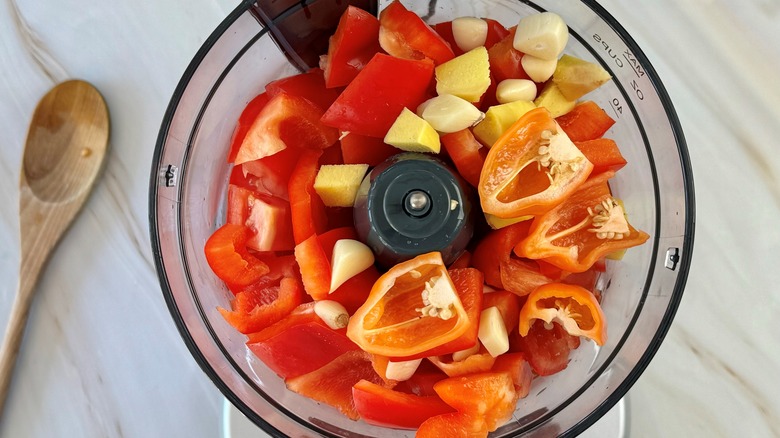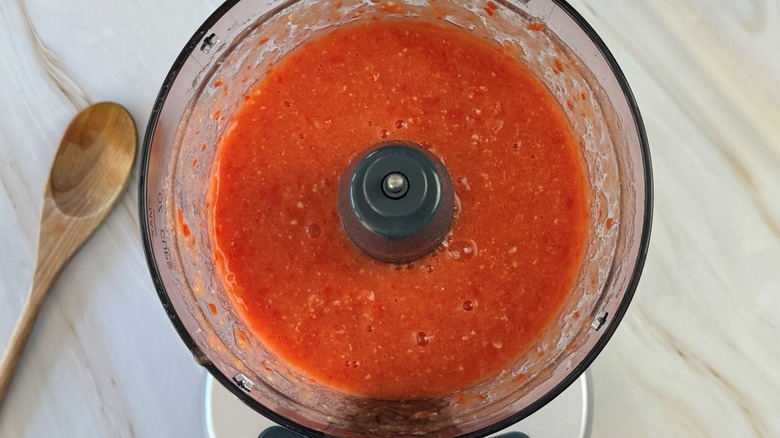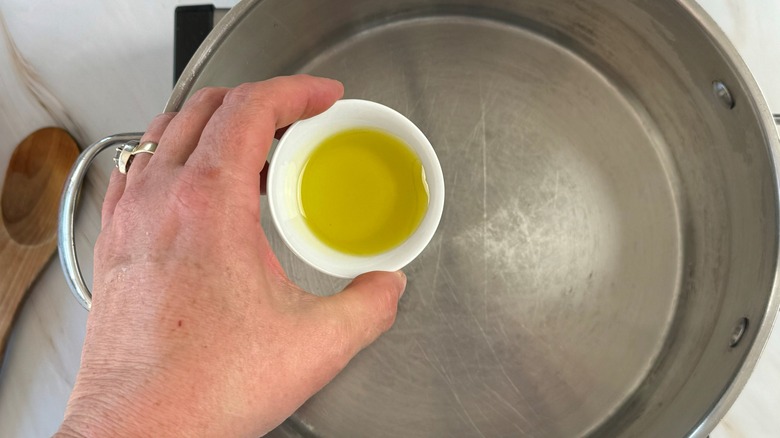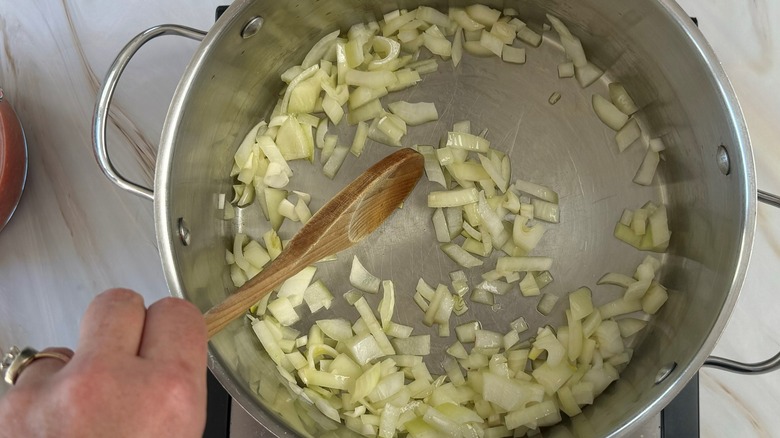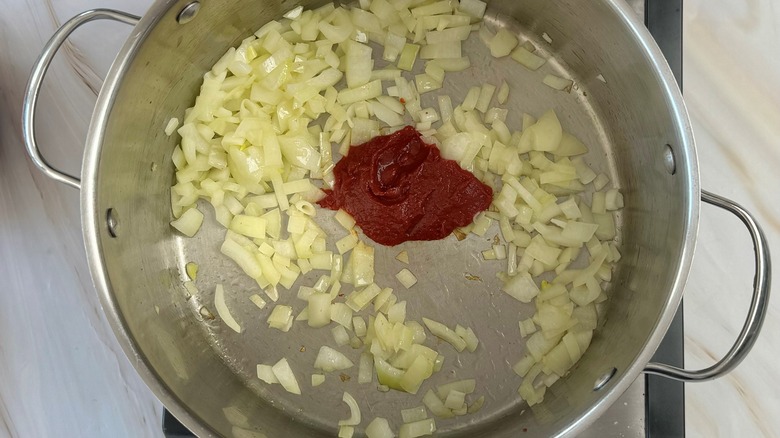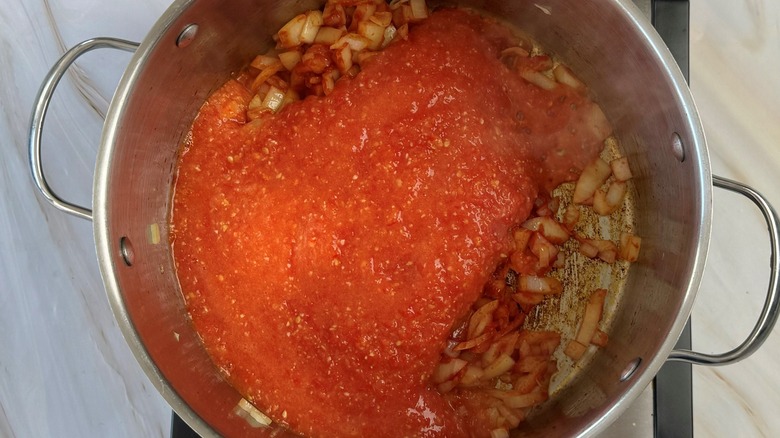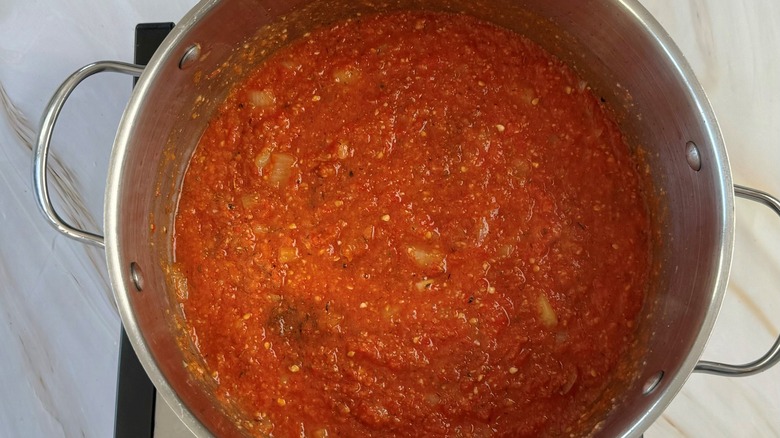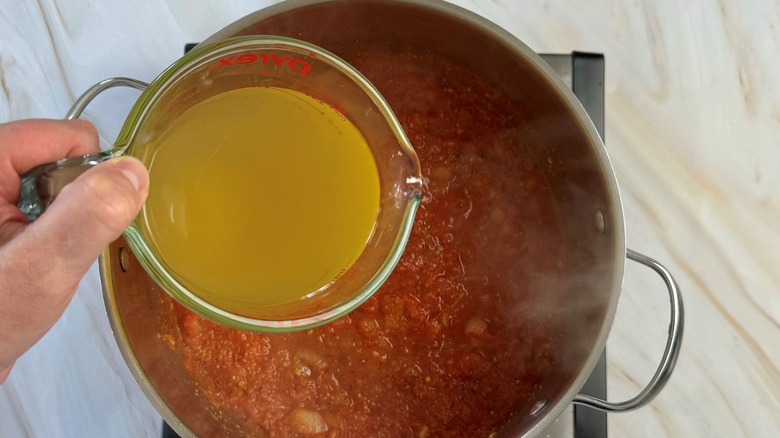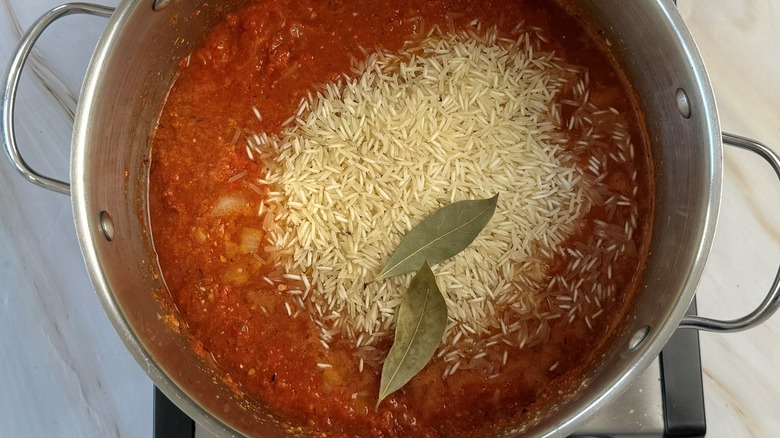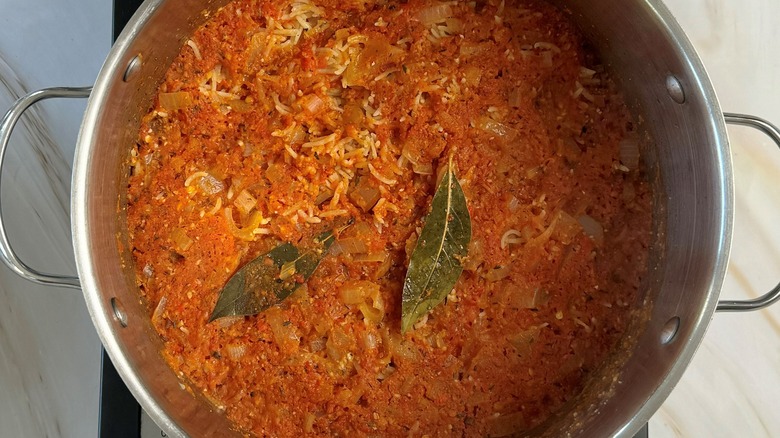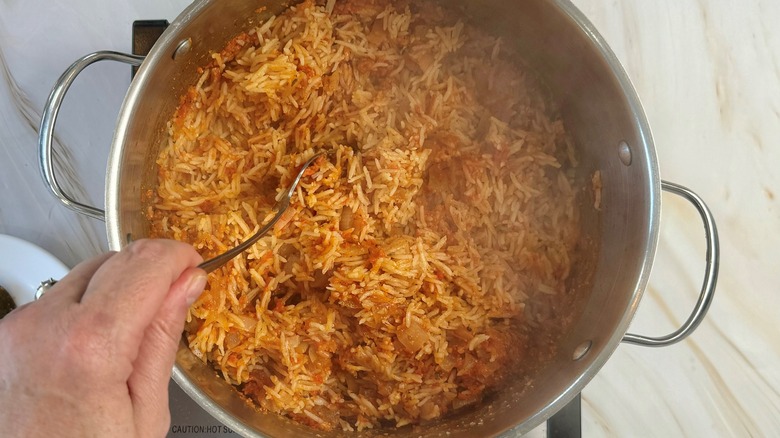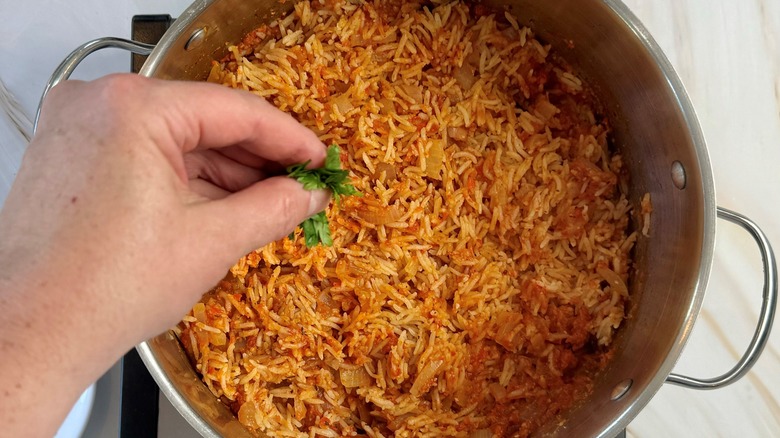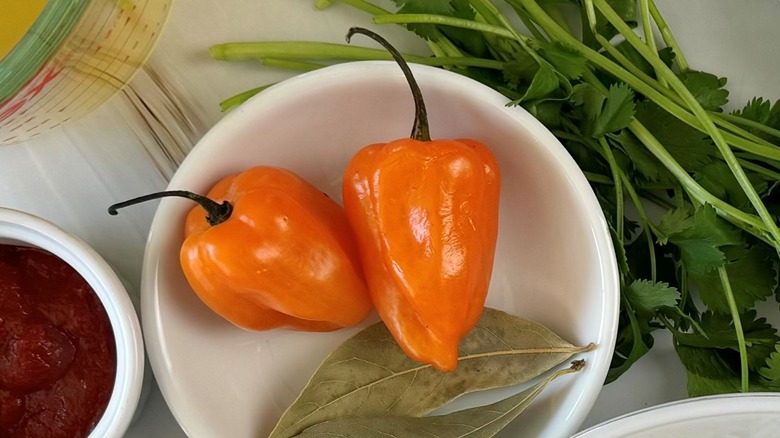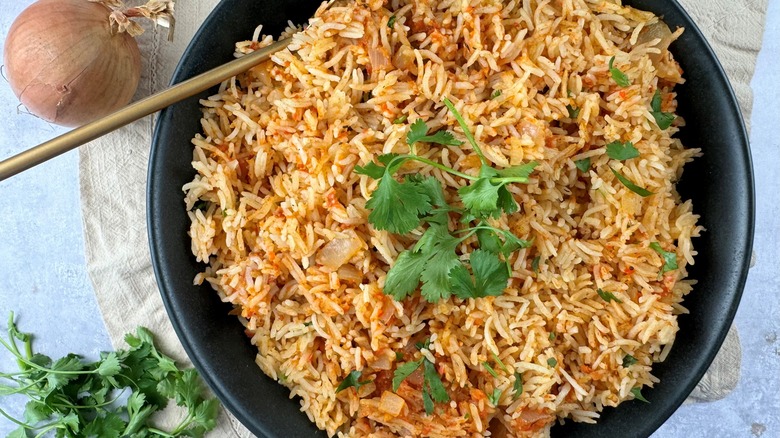West African-Inspired Jollof Rice Recipe
"Jollof rice is a popular West African rice dish that was traditionally cooked over a fire, though these days it's most often made on the stove-top or in the oven," explains recipe developer Julianne De Witt. The dish is one of many recipes you can find from cuisines throughout the world — jambalaya, risotto, paella, arroz verde — that call for raw rice to be cooked in a flavorful broth. In this recipe, the rice is cooked in both chicken broth and a fiery puree made from habanero chiles, tomatoes, and ginger. "The way it's prepared," she tells us, "ensures that the delicious flavors penetrate every grain of rice."
As jollof rice itself doesn't contain much in the way of protein, it's generally served as a side dish, although De Witt feels that it's "a step up from your usual rice side because of the savory tomatoes, warm spices, and heat from the habaneros." In Nigeria, jollof rice is usually accompanied by spicy bits of chopped meat (beef, chicken, or turkey) along with plantains, boiled or poached eggs, and coleslaw. De Witt, however, tells us "I like to serve this recipe with grilled chicken legs and a simple tomato and onion salad," adding that the leftovers can be refrigerated for up to four days.
Gather the ingredients to make West African-inspired jollof rice
De Witt starts her version of jollof rice using basmati rice, which she cooks in chicken stock along with roma tomatoes, red bell peppers, and onions. The dish is flavored with tomato paste, garlic, ginger, habanero peppers, paprika, curry powder, thyme, and bay leaves, while you'll also need salt and olive oil.
Step 1: Combine the vegetables, aromatics, and peppers
Add the tomatoes, red pepper, garlic, ginger, and habaneros to a food processor or blender.
Step 2: Puree the vegetable mixture
Blend on high until smooth and set aside.
Step 3: Warm the oil
Heat the oil in a large saucepan over medium heat.
Step 4: Fry the onions
Add the onions and saute for 2 minutes.
Step 5: Stir in the tomato paste
Add the tomato paste and stir. Cook for 1 minute.
Step 6: Add the seasonings and puree
Next add the paprika, curry powder, thyme, salt, and blended tomato pepper sauce. Stir.
Step 7: Simmer the sauce
Bring the sauce to a boil and then simmer for 10 minutes to incorporate the flavors.
Step 8: Add the stock
Stir in the stock.
Step 9: Stir in the rice
Add the rice and bay leaves. Stir.
Step 10: Steam the rice
Bring to a boil, cover with a lid, and simmer for 15 minutes or until all the liquid has been absorbed into the rice.
Step 11: Fluff the rice
Remove the lid and fluff the rice using a fork.
Step 12: Garnish the rice and serve
Garnish with cilantro, if desired, and serve.
West African-Inspired Jollof Rice Recipe
Basmati rice is cooked in a fiery habanero-ginger puree so that the delicious flavors are absorbed into every grain, in this West-African-inspired jollof rice.
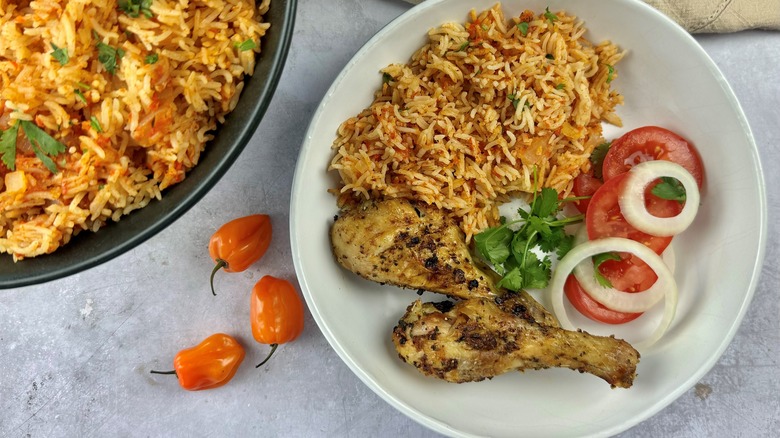
Ingredients
- 6 Roma tomatoes, chopped
- 1 red bell pepper, chopped
- 4 cloves of garlic
- 1 (1-inch) piece of ginger, peeled and chopped
- 2 habanero peppers, stems removed
- 1 tablespoon olive oil
- 1 yellow onion, diced
- 2 tablespoons tomato paste
- 2 teaspoons paprika
- 2 teaspoons curry powder
- 1 teaspoon thyme
- 2 teaspoons sea salt
- 1 ½ cups chicken stock
- 2 cups basmati rice
- 2 bay leaves
Optional Ingredients
- 2 tablespoons minced cilantro, to garnish
Directions
- Add the tomatoes, red pepper, garlic, ginger, and habaneros to a food processor or blender.
- Blend on high until smooth and set aside.
- Heat the oil in a large saucepan over medium heat.
- Add the onions and saute for 2 minutes.
- Add the tomato paste and stir. Cook for 1 minute.
- Next add the paprika, curry powder, thyme, salt, and blended tomato pepper sauce. Stir.
- Bring the sauce to a boil and then simmer for 10 minutes to incorporate the flavors.
- Stir in the stock.
- Add the rice and bay leaves. Stir.
- Bring to a boil, cover with a lid, and simmer for 15 minutes or until all the liquid has been absorbed into the rice.
- Remove the lid and fluff the rice using a fork.
- Garnish with cilantro, if desired, and serve.
Nutrition
| Calories per Serving | 320 |
| Total Fat | 4.0 g |
| Saturated Fat | 0.7 g |
| Trans Fat | 0.0 g |
| Cholesterol | 1.8 mg |
| Total Carbohydrates | 63.2 g |
| Dietary Fiber | 4.1 g |
| Total Sugars | 6.3 g |
| Sodium | 661.8 mg |
| Protein | 8.0 g |
What can I use in place of habaneros?
De Witt tells us that in West Africa jollof rice is made with scotch bonnet chiles, but adds, "As they can be hard to source, I substitute habaneros" since these peppers are similar in both flavor and heat level. If you do not crave the pain of spice, however, you can easily dial back on the heat level in this jollof rice recipe.
De Witt says one way to make this spicy dish milder would be to reduce the number of chiles and suggests using just one, but you could even go with half a pepper if you prefer. Milder varieties of chiles like fresnos (her recommendation), manzanos, or jalapeños could be used instead, while you could always omit the peppers entirely if you wish. Should other people be eating this jollof rice, too, De Witt suggests: "You could even serve a habanero hot sauce on the side to accommodate different palates." If you'd like to try making your own, we just happen to have a homemade habanero hot sauce recipe.
What are some tips for the perfect jollof rice?
As the name implies, jollof rice is all about the rice, so perfecting the dish means cooking the rice just right. It all starts with the type of rice — De Witt favors basmati, which is traditional for the Ghanaian version of jollof rice, which tends to be mild and not spicy. Nigerian jollof rice, which is the spicier kind, is typically made with long-grain white rice, and De Witt says it's okay to use this, for this recipe, too. As for rinsing the rice, De Witt explains that doing so removes some of the surface starch, saying "In theory, it makes the rice fluffier." She doesn't find it necessary, however, so she doesn't include the step in this recipe.
"Perfect jollof rice," says De Witt, "is achieved by steaming rather than boiling," which is true of rice in general. She does say, though, that if the rice is still crunchy once the liquid is absorbed, you shouldn't add more liquid but instead let it cook longer. Turn off the heat so it doesn't scorch, but cover the top of the pan with aluminum foil to trap the residual heat and moisture. Once the rice is done, De Witt tells us it "should be fluffy and fully cooked but not mushy."

